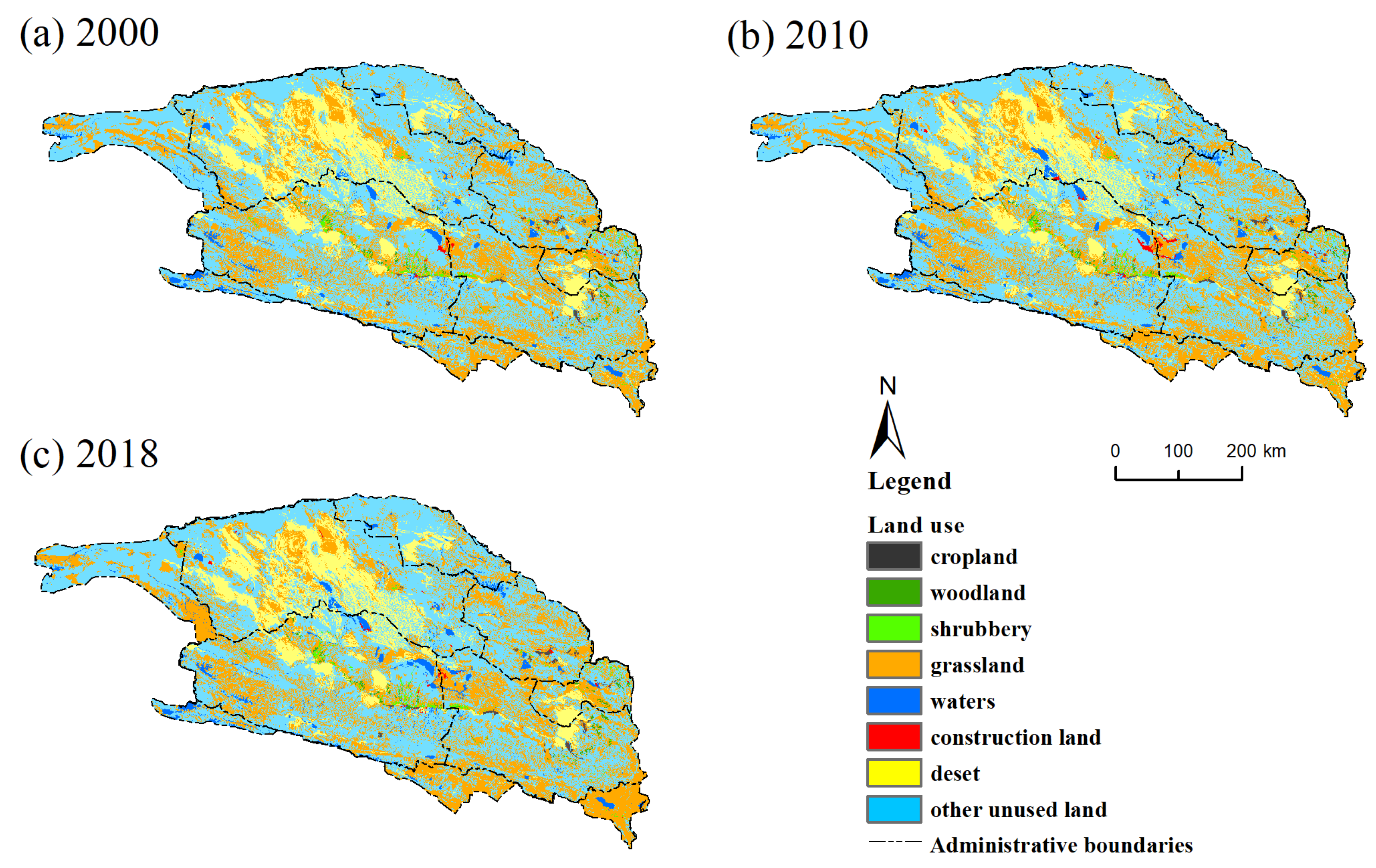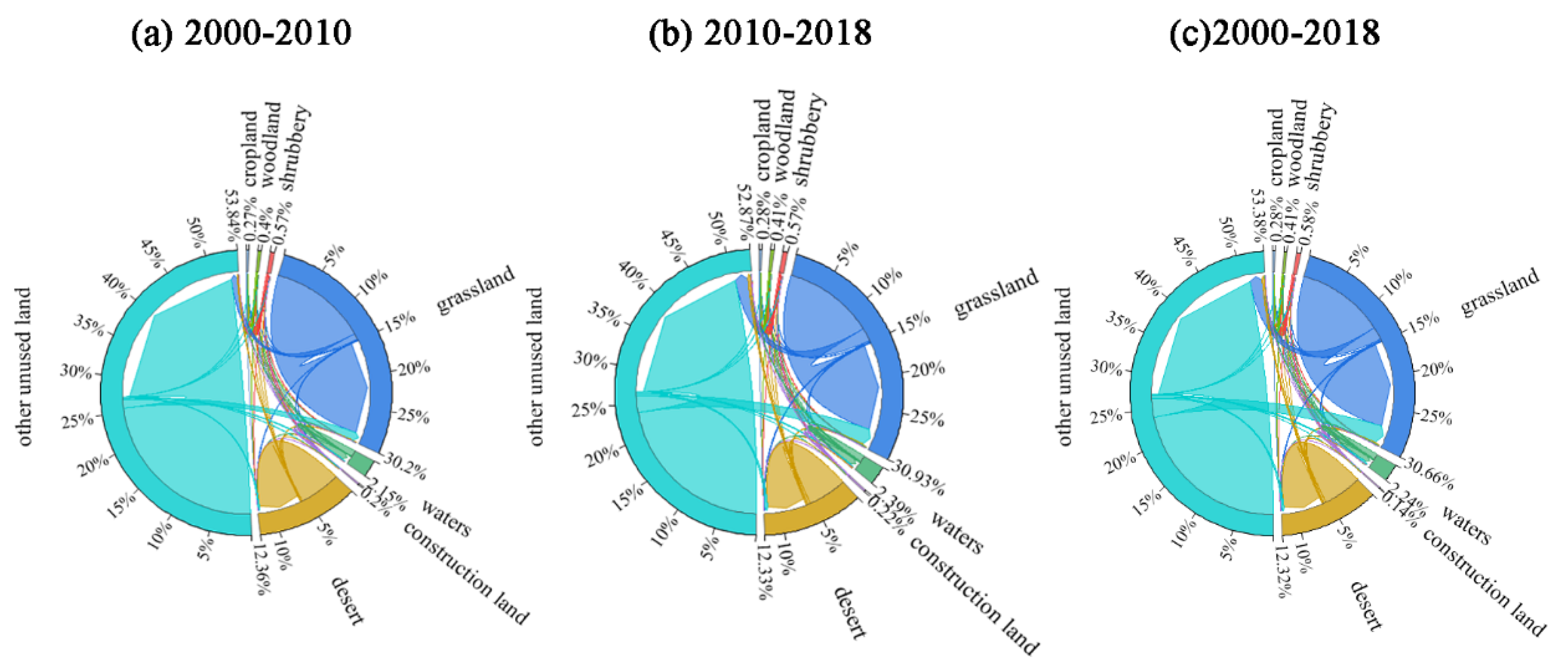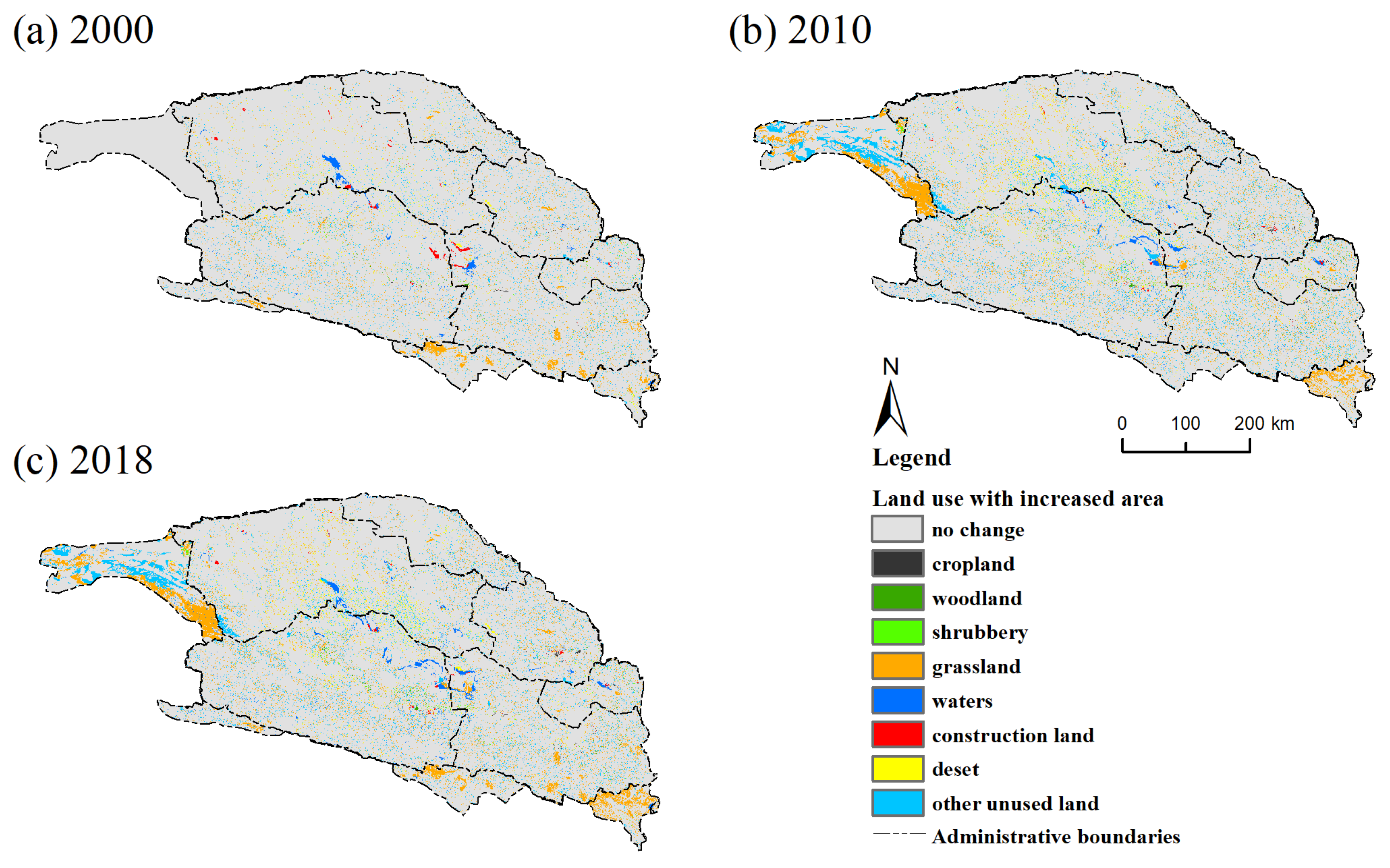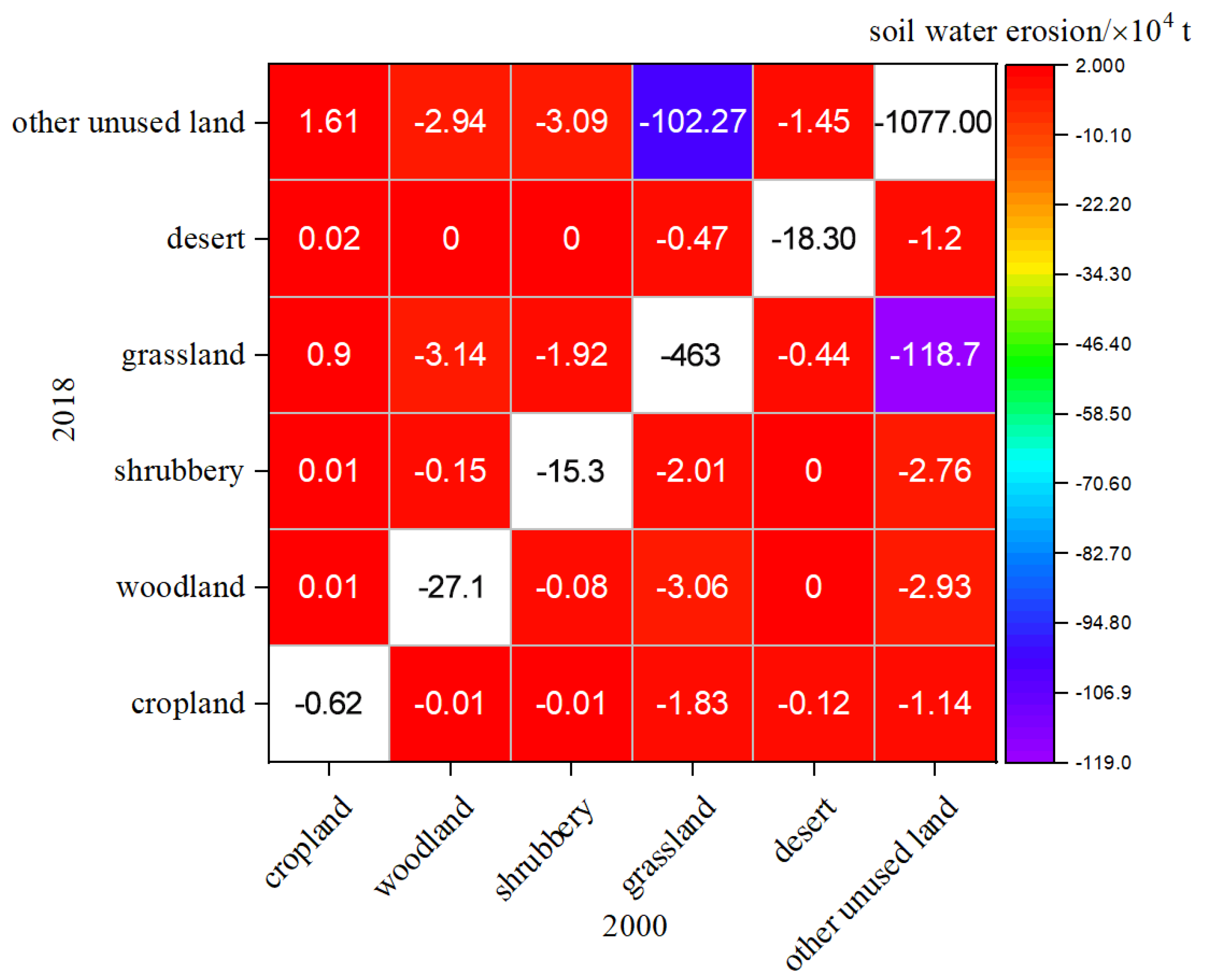Impact of Land Use/Cover Changes on Soil Erosion by Wind and Water from 2000 to 2018 in the Qaidam Basin
Abstract
:1. Introduction
2. Materials and Methods
2.1. Study Area
2.2. Modeling Soil Erosion Caused by Wind and Water
2.2.1. Modulus of Soil Erosion by Wind
2.2.2. Modulus of Soil Erosion by Water
2.2.3. Data Sources
2.3. Classification Standards of Soil Erosion by Wind and Water
2.4. Analysis of the LUCC Impact on Soil Erosion by Wind and Water
3. Results
3.1. Temporal and Spatial Changes in LUCC
3.2. Temporal and Spatial Changes of Soil Erosion by Wind and Water
3.2.1. Erosion by Wind
3.2.2. Erosion by Water
3.3. Contribution of LUCC to Soil Erosion by Wind and Water
4. Discussion
4.1. Current Status and Changing Characteristics of Soil Erosion by Wind and Water in Qaidam Basin
4.2. Characteristics of LUCC and Its Influencing Factors
4.3. The Impact of LUCC on Erosion by Wind and Water
5. Conclusions
Author Contributions
Funding
Data Availability Statement
Conflicts of Interest
References
- Du, H.D.; Jiao, J.Y.; Jia, Y.F.; Wang, N.; Wang, D.L. Phytogenic mounds of four typical shoot architecture species at different slope gradients on the Loess Plateau of China. Geomorphology 2013, 193, 57–64. [Google Scholar] [CrossRef]
- FAO. Soil Erosion: The Greatest Challenge to Sustainable Soil Management; Food and Agriculture Organization of the United Nations: Rome, Italy, 2019. [Google Scholar]
- Lal, R. Soil erosion and the global carbon budget. Environ. Int. 2003, 29, 437–450. [Google Scholar] [CrossRef]
- Van Pelt, R.S.; Zobeck, T.M.; Potter, K.N.; Stout, J.E.; Popham, T.W. Validation of the wind erosion stochastic simulator (WESS) and the revised wind erosion equation (RWEQ) for single events. Environ. Model. Softw. 2004, 19, 191–198. [Google Scholar] [CrossRef]
- Zhao, Y.Y.; Wu, J.G.; He, C.Y.; Ding, G.D. Linking wind erosion to ecosystem services in drylands: A landscape ecological approach. Landsc. Ecol. 2017, 32, 2399–2417. [Google Scholar] [CrossRef]
- Munro, R.N.; Deckers, J.; Haile, M.; Grove, A.T.; Poesen, J.; Nyssen, J. Soil landscapes, land cover change and erosion features of the Central Plateau region of Tigrai, Ethiopia: Photo-monitoring with an interval of 30 years. Catena 2008, 75, 55–64. [Google Scholar] [CrossRef]
- Song, Y.; Yan, P.; Liu, L.Y. A review of the research on complex erosion by wind and water. J. Geogr. Sci. 2006, 16, 231–241. [Google Scholar] [CrossRef]
- Tuo, D.F.; Xu, M.X.; Gao, G.Y. Relative contributions of wind and water erosion to total soil loss and its effect on soil properties in sloping croplands of the Chinese Loess Plateau. Sci. Total Environ. 2018, 633, 1032–1040. [Google Scholar] [CrossRef]
- Guo, Q.K.; Cheng, C.C.; Jiang, H.T.; Liu, B.Y.; Wang, Y.S. Comparative rates of wind and water erosion on typical farmland at the northern end of the Loess Plateau, China. Geoderma 2019, 352, 104–115. [Google Scholar] [CrossRef]
- Bahinipati, C.S.; Venkatachalam, L. Role of climate risks and socio-economic factors in influencing the impact of climatic extremes: A normalisation study in the context of Odisha, India. Reg. Environ. Change 2016, 16, 177–188. [Google Scholar] [CrossRef]
- Jiang, L.; Xiao, Y.; Zheng, H.; Ouyang, Z.Y. Spatio-temporal variation of wind erosion in Inner Mongolia of China between 2001 and 2010. Chin. Geogr. Sci. 2016, 26, 155–164. [Google Scholar] [CrossRef]
- Zhang, H.Y.; Fan, J.W.; Cao, W.; Harris, W.; Li, Y.Z.; Chi, W.F.; Wang, S.Z. Response of wind erosion dynamics to climate change and human activity in Inner Mongolia, China during 1990 to 2015. Sci. Total Environ. 2018, 639, 1038–1050. [Google Scholar] [CrossRef] [PubMed]
- Liu, S.Y.; Huang, S.Z.; Xie, Y.Y.; Leng, G.Y.; Huang, Q.H.; Wang, L.; Xue, Q. Spatial-temporal changes of rainfall erosivity in the loess plateau, China: Changing patterns, causes and implications. Catena 2018, 166, 279–289. [Google Scholar] [CrossRef]
- Jiang, L.; Xiao, Y.; Rao, E.M.; Wang, L.Y.; Ouyang, Z.Y. Effects of land use and cover change (LUCC) on ecosystem sand fixing service in Inner Mongolia. Acta Ecol. Sin. 2016, 36, 3734–3747. (In Chinese) [Google Scholar]
- Lambin, E.F.; Turner, B.L.; Geist, H.J.; Agbola, S.B.; Angelsen, A.; Bruce, J.W.; Coomes, O.T.; Dirzo, R.; Fischer, G.; Folke, C.; et al. The causes of land-use and land-cover change: Moving beyond the myths. Glob. Environ. Change 2001, 11, 261–269. [Google Scholar] [CrossRef]
- Lin, X.F.; Qu, X.B. Planning conception of soil and water conservation and ecological construction in the Three-Rivers Basin of Eastern Tibet. Yangtze River 2008, 39, 40–42. (In Chinese) [Google Scholar] [CrossRef]
- Schrobback, P.; Adamson, D.; Quiggin, J. Turning water into carbon: Carbon sequestration and water flow in the Murray–Darling Basin. Environ. Resour. Econ. 2011, 49, 23–45. [Google Scholar] [CrossRef]
- Li, J.J.; Li, Y.; Wang, Y.L.; Wu, J.S. Study of soil erosion on the east-west transects in the Three-Rivers headwaters region using 137 Cs and 210 Pbex tracing. Res. Environ. Sci. 2009, 22, 1452–1459. (In Chinese) [Google Scholar] [CrossRef]
- Woodruff, N.P.; Siddoway, F.H. A wind erosion equation. Soil Sci. Soc. Am. J. 1965, 29, 602–608. [Google Scholar] [CrossRef]
- Gregory, J.M.; Wilson, G.R.; Singh, U.B.; Darwish, M.M. TEAM: Integrated, process-based wind-erosion model. Environ. Model. Softw. 2004, 19, 205–215. [Google Scholar] [CrossRef]
- Bocharov, A.A. Description of Devices Used in the Study of Wind Erosion of Soils; Oxbnian Press: New Delhi, India, 1984. [Google Scholar]
- Fryrear, D.W.; Bilbro, J.D.; Saleh, A.; Schomberg, H.; Stout, J.E.; Zobeck, T.M. RWEQ: Improved wind erosion technology. J. Soil Water Conserv. 2000, 55, 183–189. [Google Scholar]
- Wagner, L.E. A history of wind erosion prediction models in the United States Department of Agriculture: The Wind Erosion Prediction System (WEPS). Aeolian Res. 2013, 10, 9–24. [Google Scholar] [CrossRef]
- Wischemier, W.H.; Smith, D.D.; Uhland, R.E. Evaluation of factors in the soil-loss equation. Agric. Eng. 1958, 39, 458–462. [Google Scholar]
- Renard, K.G.; Foster, G.R.; Weesies, G.A.; Mccool, D.K.; Yoder, D.C. Predicting soil erosion by water: A guide to conservation planning with the revised universal soil loss equation (RUSLE). In Agriculture Handbook 703; United States Department of Agriculture: Washington, DC, USA, 1997; p. 404. [Google Scholar]
- Liu, B.Y.; Zhang, K.L.; Xie, Y. An empirical soil loss equation. In Proceedings—Process of Soil Erosion and Its Environment Effect, Proceedings of the 12th International Soil Conservation Organization Conference, Beijing, China, 26–31 May 2002; Volume II, pp. 21–25.
- Laflen, J.M.; Lane, L.J.; Foster, G.R. WEPP: A new generation of erosion prediction technology. J. Soil Water Conserv. 1991, 46, 34–38. [Google Scholar]
- De Roo, A.P.J.; Wesseling, C.G.; Ritsma, C.J. LISEM: A single-event, physically based hydrological and soil erosion model for drainage basins. I: Theory, input and output. Hydrol. Process. 1996, 10, 1107–1117. [Google Scholar] [CrossRef]
- Morgan, R.P.C.; Quinton, J.N.; Smith, R.E.; Govers, G.; Poesen, J.W.A.; Auerswald, K.; Chisci, G.; Torri, D.; Styczen, M.E. THE European Soil Erosion Model (EUROSEM): A dynamic approach for predicting sediment transport from fields and small catchments. Earth Surf. Process. Landf. 1998, 23, 527–544. [Google Scholar] [CrossRef]
- Guo, Z.; Zobeck, T.M.; Zhang, K.; Li, F. Estimating potential wind erosion of agricultural lands in northern China using the Revised Wind Erosion Equation and geographic information systems. J. Soil Water Conserv. 2013, 68, 13–21. [Google Scholar] [CrossRef]
- Senanayake, S.; Pradhan, B.; Alamri, A.; Park, H.J. A new application of deep neural network (LSTM) and RUSLE models in soil erosion prediction. Sci. Total Environ. 2022, 845, 157220. [Google Scholar] [CrossRef]
- Yu, J. Geographical environment and prevention countermeasures of soil erosion in Qaidam Basin. Soil Water Conserv. China 2011, 9, 48–50. (In Chinese) [Google Scholar] [CrossRef]
- Wang, X.J.; Yang, M.X.; Liang, X.M.W.; Pang, G.J.; Wan, G.N.; Chen, X.L.; Luo, X.Q. The dramatic climate warming in the Qaidam Basin, northeastern Tibetan Plateau, during 1961–2010. Int. J. Climatol. 2014, 34, 1524–1537. [Google Scholar] [CrossRef]
- Chen, T.D.; Jiao, J.Y.; Wang, H.L.; Zhao, C.J.; Lin, H. Progress in Research on Soil Erosion in Qinghai-Tibet Plateau. Acta Pedol. Sin. 2020, 57, 547–564. (In Chinese) [Google Scholar] [CrossRef]
- Cuo, L.; Zhang, Y.X.; Wu, Y.Q.; Hou, M. Desertification affecting the Tibetan Plateau between 1971–2015: Viewed from a climate perspective. Land Degrad. Dev. 2020, 31, 1956–1968. [Google Scholar] [CrossRef]
- Niu, L.L.; Zhang, B.C.; Jia, T.Z.; She, D. Analysis on intensity and stability of land use change in Haixi Mongolian and Tibetan autonomous prefecture of Qinghai Province. J. Soil Water Conserv. 2021, 35, 152–159. (In Chinese) [Google Scholar] [CrossRef]
- Bryan, B.A.; Gao, L.; Ye, Y.Q.; Sun, X.F.; Connor, J.D.; Crossman, N.D.; Stafford-Smith, M.; Wu, J.G.; He, C.Y.; Yu, D.Y.; et al. China’s response to a national land-system sustainability emergency. Nature 2018, 559, 193–204. [Google Scholar] [CrossRef]
- Xu, G.Y.; Wang, Z.J.; Hu, Z.D.; Zhang, J.X. Evaluation of land use/cover change and landuse grade in Qaidam basin, China. J. Hydroelectr. Eng. 2019, 38, 44–55. (In Chinese) [Google Scholar] [CrossRef]
- Jiang, L.; Xiao, Y.; Ouyang, Z.Y.; Xu, W.H.; Zheng, H. Estimate of the wind erosion modules in Qinghai Province based on RWEQ model. Res. Soil Water Conserv. 2015, 22, 21–25. (In Chinese) [Google Scholar] [CrossRef]
- Li, D.J.; Xu, D.Y.; Wang, Z.Y.; You, X.Y.; Zhang, X.Y.; Song, A.L. The dynamics of sand-stabilization services in Inner Mongolia, China from 1981 to 2010 and its relationship with climate change and human activities. Ecol. Indic. 2018, 88, 351–360. [Google Scholar] [CrossRef]
- Fryrear, D.W.; Saleh, A.; Bilbro, J.D.; Schomberg, H.M.; Stout, J.E.; Zobeck, T.M. Revised Wind Erosion Equation (RWEQ). Wind Erosion and Water Conservation Research Unit, USDA-ARS, Southern Plains Area Cropping Systems Research Laboratory; Technical Bulletin: Washington, DC, USA, 1998. [Google Scholar]
- Xu, J.; Xiao, Y.; Xie, G.D.; Wang, Y.Y.; Jiang, Y. Computing payments for wind erosion prevention service incorporating ecosystem services flow and regional disparity in Yanchi County. Sci. Total Environ. 2019, 674, 563–579. [Google Scholar] [CrossRef] [PubMed]
- Wischmeier, W.H. Use and misuse of the universal soil loss equation. J. Soil Water Conserv. 1976, 31, 5–9. [Google Scholar] [CrossRef]
- Sharpley, A.N.; Williams, J.R. Erosion/Productivity Impact Calculator: Model Documentation; Department of Agricuture Technical Bulletin: Washington, DC, USA, 1990. [Google Scholar]
- McCool, D.K.; Foster, G.R.; Mutchler, C.K.; Meyer, L.D. Revised slope length factor for the Universal Soil Loss Equation. Trans. ASAE 1989, 32, 1571–1576. [Google Scholar] [CrossRef]
- Liu, B.Y.; Nearing, M.A.; Risse, L.M. Slope gradient effects on soil loss for steep slopes. Trans. ASAE 1994, 37, 1835–1840. [Google Scholar] [CrossRef]
- Cai, C.F.; Ding, S.W.; Shi, Z.H.; Huan, L.; Zhang, G.Y. Study of applying USLE and Geographical Information System IDRISI to predict soil erosion in small watershed. J. Soil Water Conserv. 2000, 2, 19–24. (In Chinese) [Google Scholar] [CrossRef]
- Teng, H.F.; Liang, Z.Z.; Chen, S.C.; Liu, Y.; Viscarra Rossel, R.A.; Chappell, A.; Yu, W.; Shi, Z. Current and future assessments of soil erosion by water on the Tibetan Plateau based on RUSLE and CMIP5 climate models. Sci. Total Environ. 2018, 635, 673–686. [Google Scholar] [CrossRef] [PubMed]
- Wang, L.; Zhao, X.; Zhang, C.Y.; Tang, W.J. Assessment of windbreak and sand fixation function and identification of sensitive landuse type in Mangai city based on RWEQ model. Res. Soil Water Conserv. 2023, 30, 144–153. (In Chinese) [Google Scholar] [CrossRef]
- Department of Water Resources of Qinghai Province. Soil and Water Conservation Bulletin; Department of Water Resources of Qinghai Province: Xining, China, 2019. [Google Scholar]
- Horvat, M.; Bruno, L.; Khris, S.; Raffaele, L. Aerodynamic shape optimization of barriers for windblown sand mitigation using CFD analysis. J. Wind. Eng. Ind. Aerodyn. 2020, 197, 104058. [Google Scholar] [CrossRef]
- Teng, Y.M.; Zhan, J.Y.; Liu, W.; Sun, Y.X.; Agyemang, F.B.; Liang, L.; Li, Z.H. Spatiotemporal dynamics and drivers of wind erosion on the Qinghai-Tibet Plateau, China. Ecol. Indic. 2021, 123, 107340. [Google Scholar] [CrossRef]
- Pielke, R.A. Land use and climate change. Science 2005, 310, 1625–1626. [Google Scholar] [CrossRef]
- Li, Q.; Zhang, C.L.; Shen, Y.P.; Jia, W.R.; Li, J. Quantitative assessment of the relative roles of climate change and human activities in desertification processes on the Qinghai-Tibet Plateau based on net primary productivity. Catena 2016, 147, 789–796. [Google Scholar] [CrossRef]
- Yang, W.J.; Tian, L.H.; Zhang, D.S.; Xiao, M. Benefit of Lycium barbarum plantation in Qaidam Basin aiming at the green and organic standards. J. Arid. Land Resour. Environ. 2021, 35, 151–157. (In Chinese) [Google Scholar] [CrossRef]
- Wang, J.T.; Peng, J.; Zhao, M.Y.; Liu, Y.X.; Chen, Y.Q. Significant trade-off for the impact of Grain-for-Green Programme on ecosystem services in North-western Yunnan, China. Sci. Total Environ. 2017, 574, 57–64. [Google Scholar] [CrossRef]
- Wang, Y.C.; Zhao, J.; Fu, J.W.; Wei, W. Effects of the Grain for Green Program on the water ecosystem services in an arid area of China—Using the Shiyang River Basin as an example. Ecol. Indic. 2019, 104, 659–668. [Google Scholar] [CrossRef]
- Song, W.; Deng, X.Z.; Liu, B.; Li, Z.H.; Jin, G. Impacts of grain-for-green and grain-for-blue policies on valued ecosystem services in Shandong Province, China. Adv. Meteorol. 2015, 2015, 213534. [Google Scholar] [CrossRef]
- Chi, W.F.; Zhao, Y.Y.; Kuang, W.H.; He, H.L. Impacts of anthropogenic land use/cover changes on soil wind erosion in China. Sci. Total Environ. 2019, 668, 204–215. [Google Scholar] [CrossRef] [PubMed]
- Thomaz, E.L.; Luiz, J.C. Soil loss, soil degradation and rehabilitation in a degraded land area in Guarapuava Brazil. Land Degrad. Dev. 2012, 23, 72–81. [Google Scholar] [CrossRef]
- Du, H.Q.; Dou, S.T.; Deng, X.H.; Xue, X.; Wang, T. Assessment of wind and water erosion risk in the watershed of the Ningxia-Inner Mongolia Reach of the Yellow River, China. Ecol. Indic. 2016, 67, 117–131. [Google Scholar] [CrossRef]











| Land Use | Cropland | Woodland | Grassland | Waters | Construction Land | Unused Land |
|---|---|---|---|---|---|---|
| P | 0.35 | 1 | 1 | 0 | 0 | 1 |
| Data Types | Temporal Resolution | Spatial Resolution | Format | Source | Application |
|---|---|---|---|---|---|
| Land use | 2000, 2010, 2018 | 100 m | Grid | http://www.resdc.cn (accessed on 1 March 2021) | LUCC analysis |
| DEM | 2009 | 30 m | Grid | http://www.gscloud.cn (accessed on 1 March 2021) | LS and K′ |
| Wind speed | 3 h (1 January 1998–31 December 2018) | 0.1° | Grid | http://data.tpdc.ac.cn (accessed on 1 March 2021) | WF |
| Temperature | Day (1 January 1998–31 December 2018) | Weather station | Text | Haixi Meteorological Bureau (accessed on 1 March 2021) | WF |
| Rainfall | Day (1 January 1998–31 December 2018) | Weather station | Text | Haixi Meteorological Bureau (accessed on 1 March 2021) | WF and R |
| Solar radiation | Day (1 January 1998–31 December 2018) | 0.1° | Grid | http://data.tpdc.ac.cn (accessed on 1 March 2021) | WF |
| Snow depth | Day (1 January 1998–31 December 2018) | 25 km | Grid | http://data.tpdc.ac.cn(accessed on 1 March 2021) | WF |
| SPOT-NDVI | Month (2000, 2010, 2018) | 1000 m | Grid | http://www.resdc.cn (accessed on 1 March 2021) | CRWEQ and CRUSLE |
| Soil data (texture, organic matter, calcium carbonate) | 2009 | 1:1 million | Grid | http://data.tpdc.ac.cn (accessed on 1 March 2021) | EF, SCF, and K |
| Class | Wind Erosion (t/(km2·a)) | Water Erosion (t/(km2·a)) |
|---|---|---|
| Tolerable erosion | <200 | <500 |
| Slight erosion | 200–2500 | 500–2500 |
| Moderate erosion | 2500–5000 | 2500–5000 |
| Severe erosion | 5000–8000 | 5000–8000 |
| Very severe erosion | 8000–15,000 | 8000–15,000 |
| Destructive erosion | >15,000 | >15,000 |
| 2000 | 2018 | ||||||
|---|---|---|---|---|---|---|---|
| Tolerable | Slight | Moderate | Severe | Very Severe | Destructive | Total | |
| Tolerable | 22,753.06 | 3235.27 | 0 | 0 | 0 | 0 | 25,988.33 |
| Slight | 10,112.57 | 55,290.66 | 6124.39 | 478.70 | 37.38 | 0 | 72,043.70 |
| Moderate | 7.32 | 17,935.71 | 8104.00 | 3004.78 | 1423.95 | 17.33 | 30,493.09 |
| Severe | 0 | 11,829.45 | 5227.82 | 2094.52 | 1018.92 | 739.25 | 20,909.96 |
| Very severe | 0 | 6925.69 | 11,445.09 | 5227.94 | 4796.87 | 2602.92 | 30,998.51 |
| Destructive | 0 | 194.98 | 6096.04 | 9642.78 | 20,641.59 | 60,806.51 | 97,381.90 |
| total | 32,872.95 | 95,411.76 | 36,997.34 | 20,448.72 | 27,918.71 | 64,166.01 | 277,815.49 |
| 2020 | 2018 | ||||||
|---|---|---|---|---|---|---|---|
| Tolerable | Slight | Moderate | Severe | Very Severe | Destructive | Total | |
| Tolerable | 15,5766.35 | 32,363.18 | 194.12 | 84.82 | 124.52 | 68.66 | 18,8601.65 |
| Slight | 207.74 | 36,227.60 | 23,849.32 | 4773.38 | 1015.54 | 54.19 | 66,127.77 |
| Moderate | 75.90 | 72.54 | 5306.82 | 7891.15 | 3161.67 | 374.91 | 16,882.99 |
| Severe | 37.40 | 0.12 | 34.32 | 980.58 | 2377.00 | 408.17 | 3837.59 |
| Very severe | 24.14 | 0 | 0 | 13.90 | 393.20 | 658.71 | 1089.95 |
| Destructive | 3.66 | 0 | 0 | 0 | 2.91 | 100.66 | 107.23 |
| total | 156,115.19 | 68,663.44 | 29,384.58 | 13,743.83 | 7074.84 | 1665.30 | 27,6647.18 |
Disclaimer/Publisher’s Note: The statements, opinions and data contained in all publications are solely those of the individual author(s) and contributor(s) and not of MDPI and/or the editor(s). MDPI and/or the editor(s) disclaim responsibility for any injury to people or property resulting from any ideas, methods, instructions or products referred to in the content. |
© 2023 by the authors. Licensee MDPI, Basel, Switzerland. This article is an open access article distributed under the terms and conditions of the Creative Commons Attribution (CC BY) license (https://creativecommons.org/licenses/by/4.0/).
Share and Cite
Cao, X.; Cheng, Y.; Jiao, J.; Jian, J.; Bai, L.; Li, J.; Ma, X. Impact of Land Use/Cover Changes on Soil Erosion by Wind and Water from 2000 to 2018 in the Qaidam Basin. Land 2023, 12, 1866. https://doi.org/10.3390/land12101866
Cao X, Cheng Y, Jiao J, Jian J, Bai L, Li J, Ma X. Impact of Land Use/Cover Changes on Soil Erosion by Wind and Water from 2000 to 2018 in the Qaidam Basin. Land. 2023; 12(10):1866. https://doi.org/10.3390/land12101866
Chicago/Turabian StyleCao, Xue, Yuzhuo Cheng, Juying Jiao, Jinshi Jian, Leichao Bai, Jianjun Li, and Xiaowu Ma. 2023. "Impact of Land Use/Cover Changes on Soil Erosion by Wind and Water from 2000 to 2018 in the Qaidam Basin" Land 12, no. 10: 1866. https://doi.org/10.3390/land12101866
APA StyleCao, X., Cheng, Y., Jiao, J., Jian, J., Bai, L., Li, J., & Ma, X. (2023). Impact of Land Use/Cover Changes on Soil Erosion by Wind and Water from 2000 to 2018 in the Qaidam Basin. Land, 12(10), 1866. https://doi.org/10.3390/land12101866









